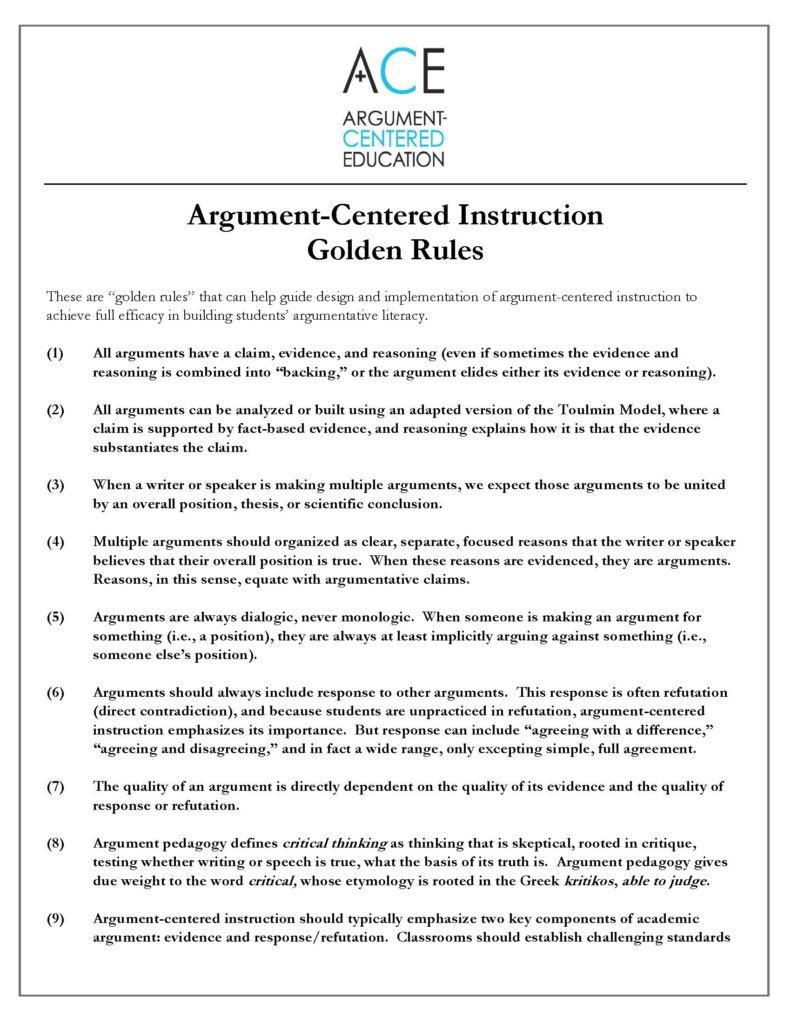
The Golden Rules of Argument-Centered Instruction
Recently a partner high school principal asked me for a set of “golden rules” that her faculty should follow when designing and implementing argument-centered instruction. These are the “golden rules” that can help teachers to achieve full efficacy in building students’ argument literacy and authentic college readiness.
Golden Rules
(1)
All arguments have a claim, evidence, and reasoning (even if sometimes the evidence and reasoning is combined into “backing,” or the argument elides either its evidence or reasoning).
(2)
All arguments can be analyzed or built using an adapted version of the Toulmin Model, where a claim is supported by fact-based evidence, and reasoning explains how it is that the evidence substantiates the claim.
(3)
When a writer or speaker is making multiple arguments, we expect those arguments to be united by an overall position, thesis, or scientific conclusion.
(4)
Multiple arguments should organized as clear, separate, focused reasons that the writer or speaker believes that their overall position is true. When these reasons are evidenced, they are arguments. Reasons, in this sense, equate with argumentative claims.
(5)
Arguments are always dialogic, never monologic. When someone is making an argument for something (i.e., a position), they are always at least implicitly arguing against something (i.e., someone else’s position).
(6)
Arguments should always include response to other arguments. This response is often refutation (direct contradiction), and because students are unpracticed in refutation, argument-centered instruction emphasizes its importance. But response can include “agreeing with a difference,” “agreeing and disagreeing,” and in fact a wide range, only excepting simple, full agreement.
(7)
The quality of an argument is directly dependent on the quality of its evidence and the quality of response or refutation.
(8)
Argument pedagogy defines critical thinking as thinking that is skeptical, rooted in critique, testing whether writing or speech is true, what the basis of its truth is. Argument pedagogy gives due weight to the word critical, whose etymology is rooted in the Greek kritikos, able to judge.
(9)
Argument-centered instruction should typically emphasize two key components of academic argument: evidence and response/refutation. Classrooms should establish challenging standards for the use of evidence and responding to other clashing or differing viewpoints, appropriate to the learning level of students, and applied in as personalized and differentiated a manner as possible.
(10)
Structured argument activities and debates should include tracking (or flowing, in debate jargon), wherever possible, because argument tracking helps keep students accountable for responding to other arguments, and it reveals argumentation to be often much less subjective than is thought.
(11)
Argumentalized units should be organized by arguable, balanced, focused, content-aligned, authentic, and energizing debatable issues.
(12)
Argument-centered instruction teaches content and skills through argument. It is ultimately a method of inquiry. It therefore is not about winning and losing arguments, but acquiring a deeper understanding of what is being argued about. Students should maintain an open mind throughout their argumentation. Often they will argue on multiple sides of an issue in order to come to their own deepened, more evidence-based, nuanced position.
Workshopping the Golden Rules
I’ve been workshopping these “golden rules” with partner school teachers this summer. We’ve used a simple protocol. If it’s a small group of instructional leaders, each teacher is given one or more of them, then they prepare for this circle-round offering to the group.
(1) Read the golden rule aloud
It is useful to hear the rules voiced by colleagues
(2) Paraphrase the golden rule in language that reflects your practice
It is important that teachers can put the rules in language that is most comfortable to them and that resonates with their own current instructional practices.
(3) Disagree or agree
Teachers should have an opportunity to express their initial response to each rule. If the teacher who is offering disagrees with the rule, they should explicate the source of their disagreement. This is followed by a brief, open discussion, in which others can offer their views. If the teacher who is offering agrees with the rule, they should offer a concrete example of the way that their current instruction applies the rule, or with an example of a way that it might apply the rule in the future.
The simplicity and directness of this protocol have been instrumental in its operational success in helping teachers assimilate these important guidelines to argument pedagogy.
Golden Terms
Though there is ample variation among education theorists, and the history of argument and rhetoric includes many bends and curves, this is what we offer as a “gold standard” in argument discourse.
Argumentative Claim
A viewpoint, interpretation, or conclusion supported by evidence and reasoning. A claim can be understood as a reason for an overall position, when a writer or speaker is making multiple arguments.
Case
A series of arguments put forward to develop and advance an overall position.
Counter-Argument
An argument that opposes or contradicts another argument. A counter-claim is a counter-argument without evidence and reasoning.
Debatable Issue
A balanced, content-aligned, focused, authentic, engaging question that is central to a discipline, unit, or lesson.
Evaluation
Comparing or resolving clashing arguments by analyzing and weighing evidence and reasoning.
Evidence
Factual, objective support an argumentative claim. Evidence varies by academic discipline, but can include data, research, statistics, examples, historical parallels, cases, textual passages, documents, computation, and testimony.
Flow Sheet
A form used to track arguments, also called a tracking form.
Inductive Argument
A probabilistic argument built up from specific instances or examples. Deductive arguments use syllogistic logic to come to conclusions whose truth is absolute, provided that its premises are also true. Inductive argument is far, far more common in both academic and public argument.
Overall Position
The broad argumentative stance that all of a writer or speaker’s arguments are meant to support. An overall position can be as blunt or as nuanced as the writer or speaker’s thinking is.
Reasoning
Analytical explanation showing how evidence substantiates a claim. Reasoning often will include three constituent parts: analysis of the evidence, warranting the evidence as support of the claim, and emphasis of the importance of the evidence to the claim and the claim to the overall position.
Rebuttal
A speech or piece of writing that directly responds to a prior speech or piece of writing.
Refutation
The process of contradicting or answering an argument or counter-argument. Refutation is one form of response to an argument or counter-argument. A response to an argument or counter-argument can include a concession, which means agreeing with a portion of an opposing argument or counter-argument.
Summary
Concise paraphrase of what someone else said or wrote. Refutation begins with
Tracking Arguments
This is the formal process of note-taking to record arguments being made in a structured argumentation activity or debate.
Warrant
Brought into argument pedagogy by Stephen Toulmin, a warrant is the principle or point of logic that justifies the evidence as evidence. Through the more common mode of academic argument today, it has been folded into reasoning.


